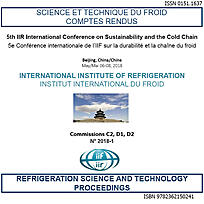
Document IIF
Effet de la surface d’évaporation sur la performance du système frigorifique à circulation par gravité.
Effect of evaporation area on performance of gravity feeding refrigeration system.
Numéro : pap. 42
Auteurs : HE W., RUNQING Z.
Résumé
The gravity feeding refrigeration system uses the principle of Thermosyphon to supply the refrigerant with large amount of liquid as the way of liquid refrigerant supply.The refrigerant supply in the evaporator is greater than the refrigerant evaporation, which ensures that the evaporation tube always keeps sufficient wetted,the flow velocity of refrigerant in the evaporating tube is improved, so that the convection heat transfer of the refrigerant side is strengthened, and the heat exchange efficiency of the evaporator is improved.The mathematical model of evaporator in gravity feeding refrigeration system is established.The new evaporators with an area of 90%, 85%, 80%, 75% and 70% of the original evaporator area is simulated in the simulation, and the most suitable evaporator used in the experimental cold storage is selected.The evaporator is processed and applied to the experiment, and the performance of the evaporator is compared with that of the original evaporator.It is concluded that the evaporator area is 75% of the original evaporator
area, which is the best match with the experimental cold storage.
Documents disponibles
Format PDF
Pages : 10
Disponible
Prix public
20 €
Prix membre*
Gratuit
* meilleur tarif applicable selon le type d'adhésion (voir le détail des avantages des adhésions individuelles et collectives)
Détails
- Titre original : Effect of evaporation area on performance of gravity feeding refrigeration system.
- Identifiant de la fiche : 30023396
- Langues : Anglais
- Source : 5th IIR International Conference on Sustainability and the Cold Chain. Proceedings: Beijing, Chine, 6-8 avril 2018
- Date d'édition : 06/04/2018
- DOI : http://dx.doi.org/10.18462/iir.iccc.2018.0042
Liens
Voir d'autres communications du même compte rendu (72)
Voir le compte rendu de la conférence
Indexation
-
Evaporation systems elements providing intensif...
- Auteurs : GOGOL O., PRITULA V.
- Date : 02/09/2009
- Langues : Anglais
- Source : Compressors 2009: 7th International Conference on Compressors and Coolants
- Formats : PDF
Voir la fiche
-
Experimental and numerical investigation of dro...
- Auteurs : JOY T. I., JACOBI A. M.
- Date : 17/07/2024
- Langues : Anglais
- Source : 2024 Purdue Conferences. 20th International Refrigeration and Air-Conditioning Conference at Purdue.
- Formats : PDF
Voir la fiche
-
Improvement of thermosyphon performance by empl...
- Auteurs : BUSCHMANN M. H., FRANZKE U.
- Date : 17/06/2013
- Langues : Anglais
- Source : 4th IIR Conference on Thermophysical Properties and Transfer Processes of Refrigerants
- Formats : PDF
Voir la fiche
-
Evaporation heat transfer of water in plate hea...
- Auteurs : KIM S. W., BAEK C., LEE J. S., et al.
- Date : 16/08/2015
- Langues : Anglais
- Source : Proceedings of the 24th IIR International Congress of Refrigeration: Yokohama, Japan, August 16-22, 2015.
- Formats : PDF
Voir la fiche
-
Theoretical and experimental simulation for det...
- Auteurs : DUARTE J. A.
- Date : 16/07/2012
- Langues : Anglais
- Source : 2012 Purdue Conferences. 14th International Refrigeration and Air-Conditioning Conference at Purdue.
- Formats : PDF
Voir la fiche
